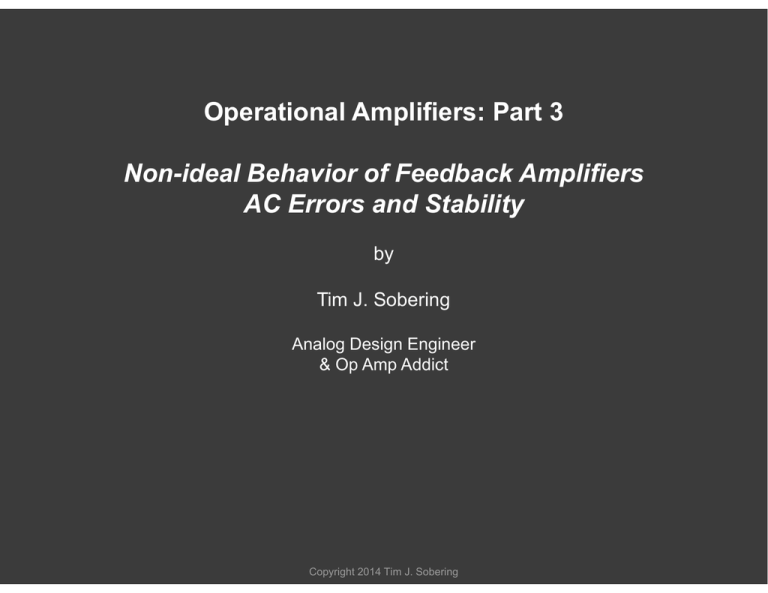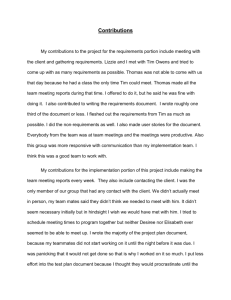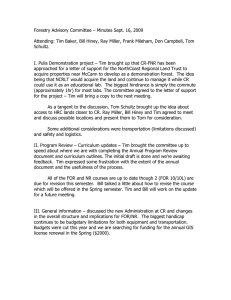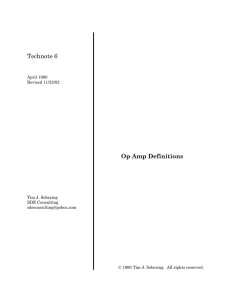Operational Amplifiers: Part 3 Non-ideal Behavior of Feedback Amplifiers by
advertisement

Operational Amplifiers: Part 3 Non-ideal Behavior of Feedback Amplifiers AC Errors and Stability by Tim J. Sobering Analog Design Engineer & Op Amp Addict Copyright 2014 Tim J. Sobering Finite Open-Loop Gain and Small-signal analysis Define VA as the voltage between the Op Amp input terminals Use KCL 0 V_OUT = Av x Va Note the “Loop Gain” – Avβ + Va - + V_OUT OUT - Av β V_IN Rg Copyright 2014 Tim J. Sobering Rf Liberally apply algebra… 0 0 1 1 1 1 1 1 1 1 Copyright 2014 Tim J. Sobering Get lost in the algebra… 1 1 1 1 1 1 1 Copyright 2014 Tim J. Sobering More algebra… Recall β is the Feedback Factor and define α 1 1 1 1 Copyright 2014 Tim J. Sobering 1 You can apply the exact same analysis to the Non-inverting amplifier Lots of steps and algebra and hand waving yields… 1 This is very similar to the Inverting amplifier configuration 1 Note that if Av →∞, converges to 1/β and –α /β –Rf /Rg If we can apply a little more algebra we can make this converge on a single, more informative, solution Copyright 2014 Tim J. Sobering You can apply the exact same analysis to the Non-inverting amplifier Non-inverting configuration Inverting Configuration 1 1 1 1 1 1 1 1 1 1 1 1 1 1 1 1 1 1 1 1 Copyright 2014 Tim J. Sobering 1 1 Inverting and Non-Inverting Amplifiers “seem” to act the same way Magically, we again obtain the ideal gain times an error term If Av →∞we obtain the ideal gain 1 1 1 Avβ is called the Loop Gain and determines stability If Avβ –1 1180° the error term goes to infinity and you have an oscillator – this is the “Nyquist Criterion” for oscillation Gain error is obtained from the loop gain 1 1 1 For < 1% gain error, 40 dB (2 decades in bandwidth!) Copyright 2014 Tim J. Sobering Control-system block representations of Inverting and Non-Inverting Amplifiers This one is in all the books… …but you rarely see this one From a stability perspective, the amplifiers are the same. The inverting configuration has A modifier on the input signal Copyright 2014 Tim J. Sobering An Op Amp has no idea what type of amplifier it is Ground is an arbitrary definition No ground pin on a Op Amp Inverting + OUT VIN V_OUT - Non-Inverting Rg Rf This is a critical point Signal gain is not important (to the Op Amp) Loop Gain (Avβ ) is what matters for stability, overshoot, and ringing Copyright 2014 Tim J. Sobering So what’s important to remember? Open Loop Gain (Av) Op Amps are designed with high DC gain (80-140 dB) and a “dominant” low frequency pole (10 Hz to 1 kHz) The dominant pole contributes an automatic –90° phase shift in Av There is usually a second pole located after the gain curve crosses 0 dB The 2nd pole can be located before 0 dB in uncompensated amplifiers ○ Watch for amplifiers that say “Stable for gains greater than…” Open Loop Gain decreases with frequency by –20 dB/decade Unity gain crossover frequency (ft or fτ) is well controlled DC open loop gain and location of dominant pole is not well controlled Manufacturer Phase Margin specification only includes poles in Av (assumes β 1) Copyright 2014 Tim J. Sobering …and a few more important facts Feedback Factor (β ) β includes reactive elements so it will also introduce a phase shift ○ Even when composed “purely” of resistive components If β contributes sufficient phase shift in combination with the pole(s) in Av, the circuit will ring or oscillate Noise Gain (1/β ) Signal gain doesn’t matter, only noise gain You have some control over noise gain ○ You don’t control Open Loop Gain (except to pick a different Op Amp) ○ So Noise Gain is the important gain for bandwidth and stability Gain-bandwidth product (GBW) is ft f3dB/β ○ Note: Inverting and non-inverting configurations have the same bandwidth if they have the same noise gain Copyright 2014 Tim J. Sobering Tricks with noise gain OPA637 Uncompensated version of the OPA627 ○ Stable for gains 5 (OPA627 is unity gain stable) GBW 80 MHz (vs 16 MHz for the OPA627) SR 135 V/µs (vs 55 V/µs for OPA627) I can make a unity gain buffer with the OPA637 by manipulating the noise gain Acl 1 but 1/β 11 Noise gain is only high at higher frequencies (due to cap) 7 V_POS 3 VS 0.1uF 511 2 V+ + - CASE 4 OUT T2 T1 V-U30 6 5 1 OPA637/BB V_NEG 5.11k Copyright 2014 Tim J. Sobering 8 V_OUT Tricks with noise gain (con’t) The OPA637 is extremely stable with a N.G higher slew rate it yields a “better” buffer 11 and with the OPA637 12V 10V 8V 6V 4V OPA627 2V 0V -2V -4V -6V -8V -10V -12V 0s 0.1us 0.2us V(U4:OUT) V(U5:OUT) 0.3us 0.4us 0.5us 0.6us 0.7us 0.8us 0.9us 1.0us 1.1us 1.2us 1.3us 1.4us 1.5us 1.6us 1.7us 1.8us Time Copyright 2014 Tim J. Sobering 1.9us 2.0us 2.1us 2.2us 2.3us 2.4us 2.5us 2.6us 2.7us 2.8us 2.9us 3.0us Open Loop Gain and Phase Manufacturer Specs Compensated Op Amp See 2ND pole location Assumed β 1 For Phase Margin “estimate” Manu. doesn’t know how you will use their Op Amp Copyright 2014 Tim J. Sobering Noise Gain, Phase of Loop Gain: Resistive Feedback Compensated Op Amp Purely resistive feedback β 0.1 (Gain 20 dB) fcl – closed-loop BW Increasing Gain Error Copyright 2014 Tim J. Sobering Noise Gain, Phase of Loop Gain: Zero in Noise Gain Compensated Op Amp β 0.1 (Gain 20 dB) Zero in 1/β →pole in Avβ fcl – closed-loop BW No Phase Margin Will oscillate at fcl Copyright 2014 Tim J. Sobering Noise Gain, Phase of Loop Gain: Zero in Noise Gain, Compensating Copyright 2014 Tim J. Sobering f Compensated Op Amp β 0.1 (Gain 20 dB) Zero in 1/β →pole in Avβ Compensating pole in 1/β from Cf Stable response How does a zero get into the Noise Gain? Noise Gain zero’s are poles in β Output Impedance interacting with a capacitive load ○ Cable driver Feedback resistors interacting with the Op Amp’s differential and common mode input capacitance “High-Z” source adding capacitance to amplifier input ○ Photodiodes and Piezoelectric sensors Compensation methods Pick Op Amp with higher capacitive load tolerance Add feedback capacitance to introduce compensating pole in N.G. Reduce resistor values so N.G. zero moves to frequency fτ Problems Peaking in noise gain increases integrated noise Reduced Phase Margin results in overshoot and ringing (step response) Copyright 2014 Tim J. Sobering Example using Op Amp input capacitances OPA627 Specification Differential 1013 Ω || 8 pF Common-mode 1013 Ω || 7 pF Capacitance on inverting node totals Cin Pole and zero relative to 1/β 15 pF 1 2 + CCM 1 OUT CDM - 2 CCM V_IN Rg Rf Cf Copyright 2014 Tim J. Sobering V_OUT Example using Op Amp input Capacitances OPA627 open-loop gain and phase 140 100 50 -0 -50 Θ -100 -150 -180 1.0Hz DB(V(AV)) 3.0Hz P(V(AV)) 10Hz 30Hz 100Hz 300Hz 1.0KHz 3.0KHz 10KHz 30KHz 100KHz 300KHz Frequency Copyright 2014 Tim J. Sobering 1.0MHz 3.0MHz 10MHz 30MHz 100MHz 300MHz 1.0GHz Example using Op Amp input Capacitances Let Cin 15 pF, Cf 0 pF, Rf fz 19.9 kHz, fp ∞ 1 MΩ, Rg 1 MΩ 140 100 50 1 -0 -50 Θ -100 -150 -180 1.0Hz DB(V(AV)) 3.0Hz P(V(AVB)) 10Hz VDB(Av)- VDB(AvB) 30Hz 100Hz 300Hz 1.0KHz 3.0KHz 10KHz 30KHz 100KHz 300KHz Frequency Copyright 2014 Tim J. Sobering 1.0MHz 3.0MHz 10MHz 30MHz 100MHz 300MHz 1.0GHz Example using Op Amp input Capacitances Let Cin 15 pF, Cf 1 pF, Rf fz 19.9 kHz, fp 159 kHz 1 MΩ, Rg 1 MΩ 140 100 50 1 1 1 -0 -50 Θ -100 Phase Margin -150 -180 1.0Hz DB(V(AV)) 3.0Hz P(V(AVB)) 10Hz VDB(Av)- VDB(AvB) 30Hz 100Hz 300Hz 1.0KHz 3.0KHz 10KHz 30KHz 100KHz 300KHz Frequency Copyright 2014 Tim J. Sobering 1.0MHz 3.0MHz 10MHz 30MHz 100MHz 300MHz 1.0GHz Feedback Capacitance…does it help? OPA627 step response, Gain +2, Rf Rg 1kΩ,10kΩ,100kΩ as you move to lower graphs Green – no feedback cap, Red – 5 pF feedback cap 4.0V 3.0V 2.0V 1.0V 0V V(U14:OUT) V(U17:OUT) V(U13:OUT) V(U16:OUT) 4.0V 3.0V 2.0V 1.0V 0V 4.0V 3.0V 2.0V 1.0V SEL>> 0V 0s 0.5us 1.0us V(U15:OUT) V(U18:OUT) 1.5us 2.0us 2.5us 3.0us 3.5us 4.0us 4.5us 5.0us 5.5us 6.0us 6.5us Time Copyright 2014 Tim J. Sobering 7.0us 7.5us 8.0us 8.5us 9.0us 9.5us 10.0us 10.5us 11.0us Overshoot as a function of Phase Margin Enter the left side at the value of the starting variable, then move vertically (constant damping factor) to find the corresponding values from the other curves For example, if your phase margin is 30 degrees, move to the right from the y-axis on the 30 degree line until you reach the red PM line, and then move vertically to the blue line and read %OS ~ 45% overshoot and to the magenta line and read Q ~ 2. Copyright 2014 Tim J. Sobering 55° → 13.3% overshoot 60° → 8.7% overshoot 65° → 4.7% overshoot 70° → 1.4% overshoot 75° → 0.008% overshoot Picking a value for f Case 1: high-gain and large Recall 1 2 1 2 If the gain is high… → f 1 Place noise gain pole at the closed loop BW (fcl) 1 2 2 Source: “Troubleshooting Analog Circuits”, Robert A. Pease; modifications by Tim J Sobering, “Technote 9: A Starting Point for Insuring Op Amp Stability” Copyright 2014 Tim J. Sobering Picking a value for f Case 2: low-gain or small impedance Condition for the gain is low and impedance being low 1 ‖ 2 4 Translation…zero is located 4x higher than fcl Recall the effect of pole or zero on the phase margin starts a decade before its location Place the pole at a frequency twice that of the zero 1 2 2 2 1 ‖ Keep in mind these are general starting points – Build it and Bang on it! 2 Copyright 2014 Tim J. Sobering Questions? Run away! Copyright 2014 Tim J. Sobering





